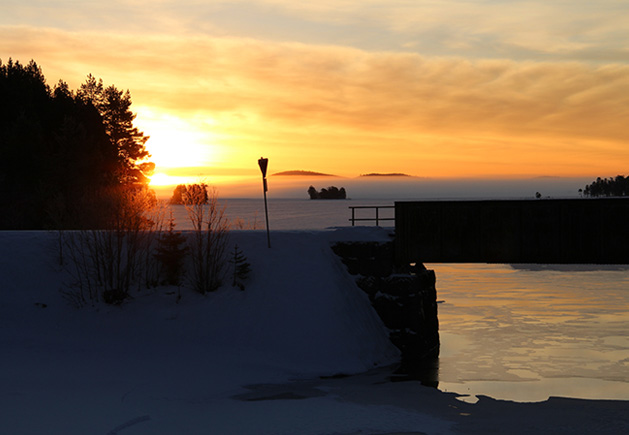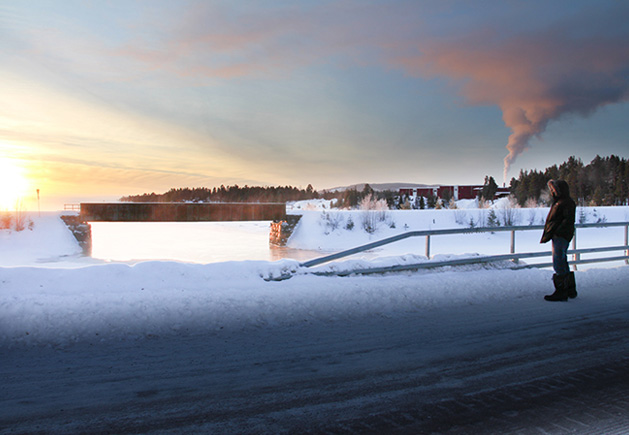FROZEN

So I found myself stranded in the Arctic Circle. The taxi transporting my film crew and I had had an unfortunate mishap involving a deep pile of snow and a patch of the blackest ice. I went to take a sip from my water bottle but it had frozen solid. I took out my phone to find the nearest town, blinking through crystals of ice that had formed on my eyelashes, only to discover that my Lithium battery had died in the extreme cold.
Welcome to the frozen North.
I had always wanted to travel to the Arctic Circle but had never managed to get there. It is not the first place you think of for a family holiday and my wife hadn’t mentioned it in her list of ‘Top 10 Weekends Away’. So, when the opportunity arose to film there, I leapt at the chance and started to plan for a week of sub-zero adventure.
A normal filming day on any location involves getting up at around 5am and finishing late. You have to eat when you can and be prepared for an awful lot of standing around. This is fine when you’re filming in a city but standing around in sub-zero temperatures can take its toll on your health. So, rule number one was to wear the correct gear – a head-to-toe duvet with three sets of gloves, and boots. Arriving on location, I duly donned the duvet and the three sets of gloves but when temperatures were not so cold the gloves prevented me from unzipping myself from the duvet coat and I almost became the first man ever to be admitted to hospital in the Arctic with heat exhaustion.

As well as physical discomfort, filming in the Arctic presents a few other problems. Things we take for granted at home, such as maps and sat navs to guide you, don’t really work here. To use a map correctly it helps to have a point of reference, but when you’re driving past one ice lake after another the landscape, although bleakly stunning, becomes slightly confusing and you begin to doubt your judgement. “Did I take the right turn?” “Was that even a road?”
Of course, modern cameras are amazing when it comes to dealing with extremes of heat and cold, but condensation is always a problem. Taking equipment in and out of warm cars clouds your lenses and there was a lot of time spent wiping and reshooting when the lens misted up mid-shot. On top of that, tripods would freeze so we spent a lot of time building ‘snow tripods’, which were highly effective.
Flying a drone was particularly tricky. The extreme cold cut down its battery life and ice would frequently interrupt the rotors, causing us to abandon mid-shot. Although it was a slight pain to use in these conditions, the drone was extremely beneficial not only as a tool to shoot great shots but also in helping us find our bearings – and in helping us track down a reindeer (we did).
Days are short in winter, which puts extra pressure on you to capture your shots in time. One advantage of this is that dawn and dusk go on forever. If you’re after the kind of blue light captured in ‘The Revenant’, a winter shoot is perfect. If you’re after low winter sun, it skims the horizon for a couple of hours before dusk.
The advantage of the long winter nights in the Arctic Circle is that you can go off exploring the Aurora Borealis, or northern lights. This appears when solar wind particles collide with air molecules in the earth’s atmosphere, transferring their energy into light. One night we trekked deep into the woods, aware that any light pollution would inhibit our eyes from adjusting to the dark. We were aware that there was Aurora activity that night and we were not disappointed. Before long, we were encircled by an eerie green light that ebbed and flowed across the sky. It could have been set to music, conducted by Odin himself and set to an orchestra of ‘oohs’ and ‘aaahs’ as the light danced across the sky.
There are far too many positives to write about filming in the Arctic Circle, so I will just list a few of them:
The sunrises are stunning and, unlike those in tropical climes, last for hours.
If you like that blue dusky look, like in the Revenant, it’s like that nearly all day.
Reindeers are everywhere. But frustratingly not when you want to film one.
You can skidoo across frozen lakes in total darkness – heaven.
If you’ve heard of Hygge (look it up) there’s a lot of that here.
The cold is a nice cold – not a wet, miserable, England cold.
If you like eating moose, there’s a lot of that.
The people are tough, resourceful and very happy.
You can eat Meatballs (probably Moose) for breakfast, like in IKEA.
You can see the Northern Lights. Worth the trip alone.
We don’t just film in the extremes. If you have any projects that are closer to home we would love to hear from you.
